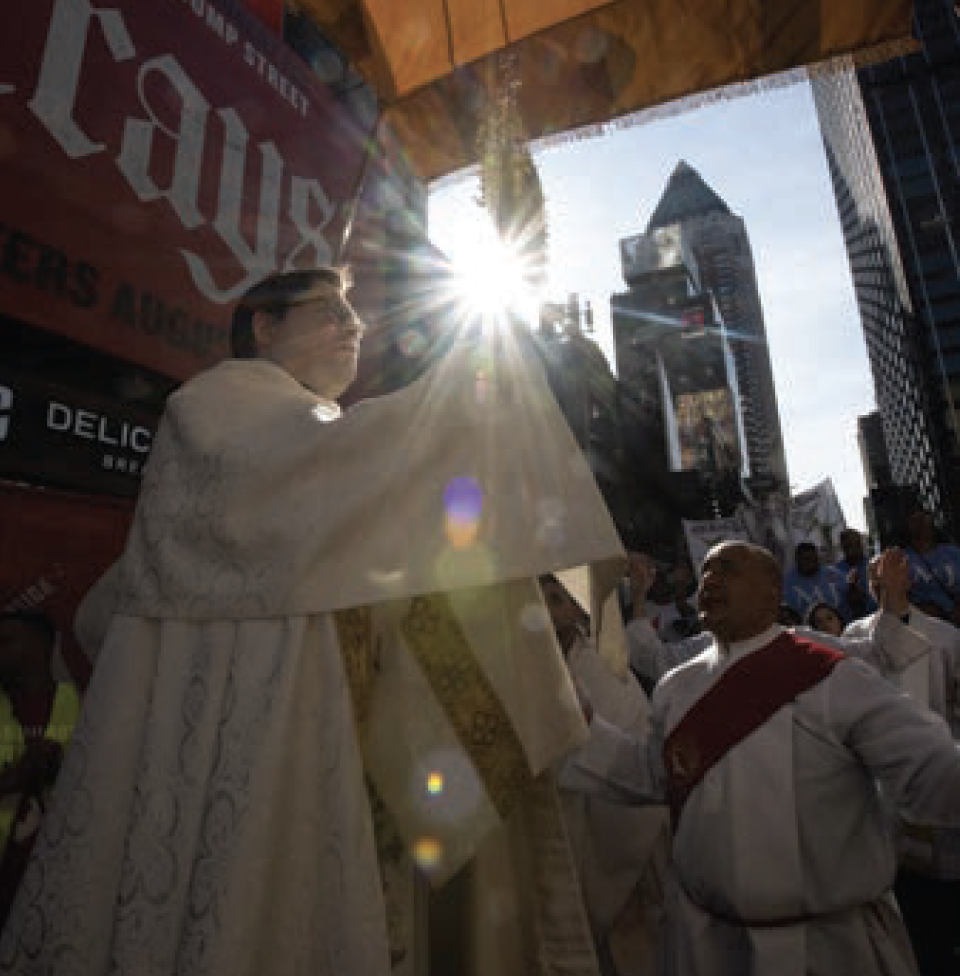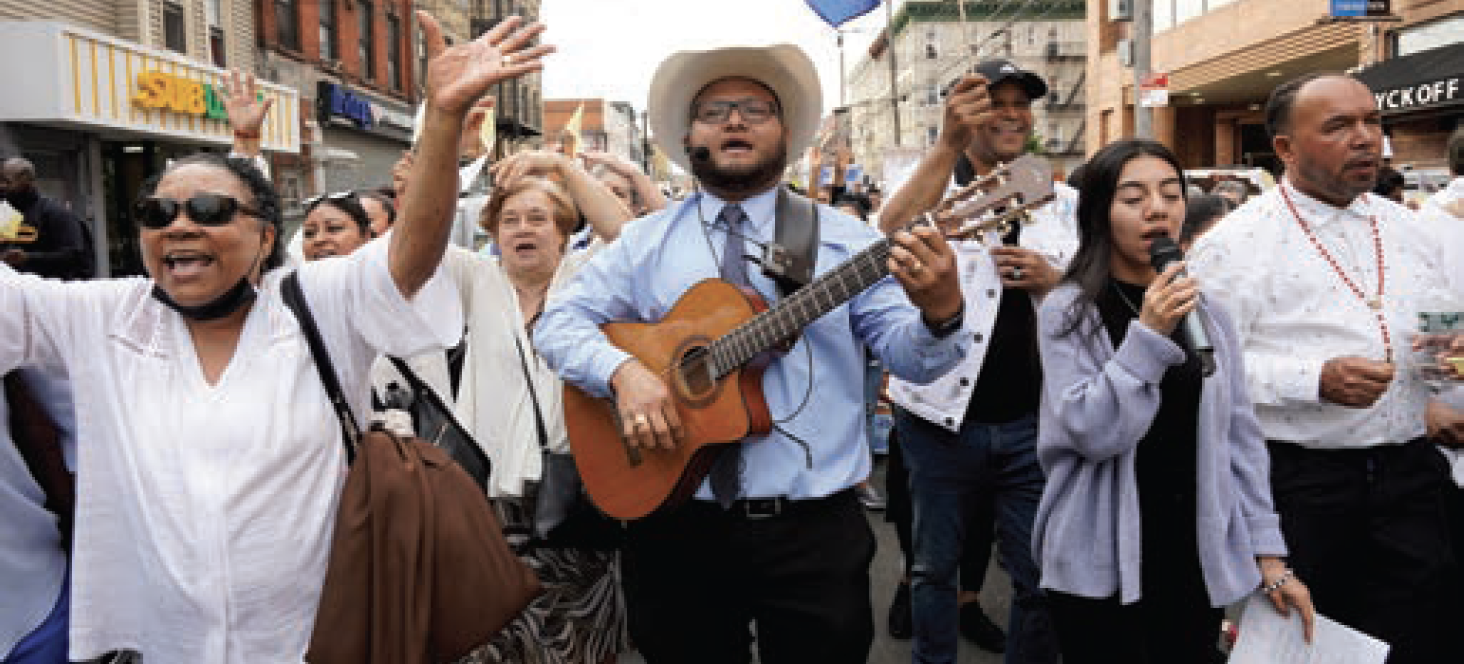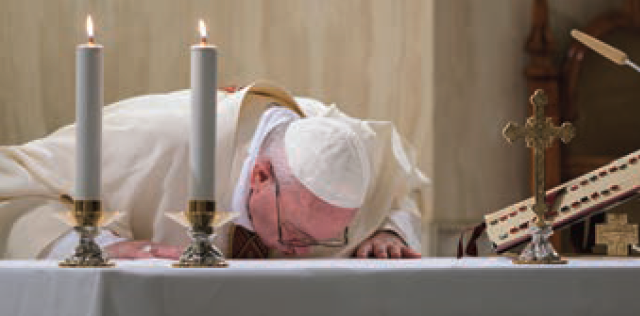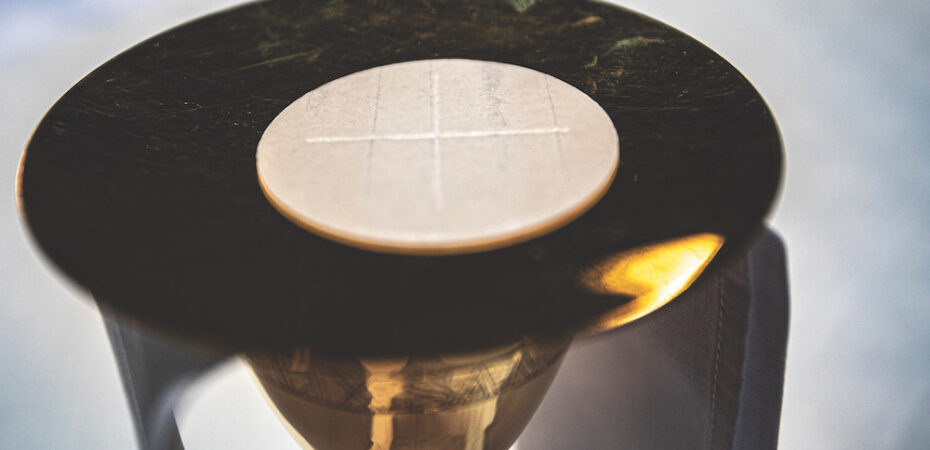The Eucharistic Prayer
A meeting place for the National Eucharistic Revival and the ‘ars celebrandi’
Father Gerald Dennis Gill Comments Off on The Eucharistic Prayer
The National Eucharistic Revival now underway in our country is a worthy concern of all priests. The Eucharistic Revival, as a project of the United States Conference of Catholic Bishops, commenced on June 19, 2022, the solemnity of the Most Holy Body and Blood of Christ (Corpus Christi) and is planned for a three-year period.
The mission of the revival is “to renew the Church by enkindling a living relationship with the Lord Jesus Christ in the Holy Eucharist.” The revival envisions “a movement of Catholics across the United States, healed, converted, formed and unified by an encounter with Jesus in the Eucharist — and sent out on mission ‘for the life of the world’ (Jn 6:51)” (cf. www.eucharisticrevival.org/mission-vision-and-timeline).
This mission and vision of the Eucharistic Revival, as hopeful as they sound and critical for the genuine life and work of the Church, begs some questions. What is the starting point? How do we discover this “living relationship with the Lord Jesus Christ in the holy Eucharist”? Can we be “unified by an encounter with Jesus in the Eucharist”?
All three of these questions point to the celebration of the Eucharist itself. This is where the revival will be most effective and take root, especially for the majority of Catholics. Perhaps another question is needed for the answer to the three already proposed. Is there a link between the lofty mission and vision of the Eucharistic Revival and the manner of the celebration of the Eucharist?
……………………………………………………………………………………………………………………………………………
Deepening the Experience of the Eucharistic Prayer
In order to heighten the meaning and role of the Eucharistic prayer to foster a revived faith in the Eucharist itself, several other points need to be reconsidered. At the consistent urging of the Church, all the hosts and wine needed for the Communion of the people are to be consecrated during the Eucharistic prayer. This practice demonstrates more than any that the Communion of all is from the sacrifice actually being celebrated with the Eucharistic prayer (cf. Sacrosanctum Concilium, No. 55; General Instruction of the Roman Missal, No. 85).
Additionally, the reception of holy Communion under both kinds as a regular practice gives expression to the divine will of the Savior as he gave the chalice of his blood to his disciples and now to all of us with the Eucharistic prayer (cf. The Order of Mass, Roman Missal, No. 90: GIRM, No. 281). Sometimes, an overriding concern about what is practical when it comes to these two points diminishes their impact on deepening the faith of all in the action of Christ in this prayer.
There are 10 Eucharistic prayers in the current and third edition of the Roman Missal along with numerous prefaces. The preface and prayer chosen do make a difference and impact the reception of the mystery of Christ. The General Instruction of the Roman Missal provides guidance for this choice with a preference for Eucharistic Prayer I and III for Sundays (cf. Nos. 364-365). Additionally, the singing of the Eucharistic prayer on occasion according to forms in the Roman Missal serves to highlight the theological value of the prayer. The National Eucharistic Revival offers all priests an opportunity to consider anew the overarching role of the Eucharistic prayer in all its dimensions to intensify the faith of all in the Eucharistic Mystery.
……………………………………………………………………………………………………………………………………………
The ars celebrandi, the proper carrying out of the Eucharistic rite, begins to answer these questions. Maybe the greatest contribution that priests can make to the fruitfulness of the Eucharistic Revival is to reclaim who we are as priests in the action of the Eucharist and our responsibility for the manner of celebration. In this way, the very mystery of Christ leads us, with all the baptized, into a real living relationship with Christ and profoundly unites us with Christ the Priest in the worship of the Father in the Spirit for the work of the Gospel. For us priests, the Eucharistic Revival occasions a renewed serious engagement of the celebration of the Eucharist with its ars celebrandi.
The term ars celebrandi is popular today, but its use often lacks sufficient understanding. Pope Benedict XVI translated it as “the art of proper celebration” in his discussion of the topic in Sacramentum Caritatis (cf. No. 38). The current use of the term dates back to Pope St. John Paul II and finds a significant place in the recent apostolic letter Desiderio Desideravi, by Pope Francis on liturgical formation.
What does the term mean? The art of proper celebration begins with the event the liturgy celebrates, the actual death and resurrection of the Lord, the Paschal Mystery of Christ, which happened in time and belongs to eternity, which is present to the Church when she assembles in the Spirit for every liturgical celebration. This same Spirit, through words, symbols and actions in every liturgical celebration, brings the priest and people into a living relationship with the Paschal Mystery of Christ (cf. Catechism of the Catholic Church, No. 1101). The primary artist is the Lord Jesus in his death and rising. The art of proper celebration seeks to carry out every aspect of the liturgical celebration, on the part of all, in communion with the saving action of Jesus for the worship of the Father and so to share in the newness of divine life that comes from the Holy Spirit.
The ars celebrandi is so much more than doing the red and reading the black in the ritual books. The ars celebrandi is a skill that comes from formation on the part of the priest and people to know and believe in the invisible reality of the Paschal Mystery that receives expression and meaning in every instance of the liturgical celebration. The ars celebrandi allows the liturgical rites to be celebrated as given to us by the Church and to move Godward in an intentional way. Everyone, the ordained and the baptized, has a role in the ars celebrandi, “the art of proper celebration.” However, the priest celebrant carries a unique responsibility to promote, to ensure, to deepen the worship of the baptized in the celebration of the sacred liturgy. As priests, therefore, our manner of celebration of the Eucharist, rooted in faith and guided by the directions of the Church, promises to be a principal source for the revival of faith for the people and our own in the Eucharistic mystery that takes place through our hands at the altar.

Eucharistic Prayer
The whole celebration of the Eucharist and its required ars celebrandi deserves attention as far its place in the revival of Eucharistic faith. However, the Eucharistic prayer, as “the center and high point of the entire celebration” (General Instruction of the Roman Missal, No. 78), deserves special attention above all. With this prayer, the action of the Eucharist is fully realized. The General Instruction of the Roman Missal (GIRM) describes the liturgical action and theological content of this Prayer in a rather succinct way:
“The priest calls upon the people to lift up their hearts towards the Lord in prayer and thanksgiving; he associates the people with himself in the prayer that he addresses in the name of the entire community to God the Father through Jesus Christ in the Holy Spirit. Furthermore, the meaning of this prayer is that the whole congregation of the faithful joins with Christ in confessing the great deeds of God and in the offering of sacrifice” (No. 78).
The Eucharistic prayer takes place with the priest and people having distinct roles, yet acting together. The preface dialogue declares the praying of this prayer is a sacramental action of the whole Christ, Head and members, with the priest and people. The priest directs himself to the baptized, “The Lord be with you.” The baptized are linked to the priest, “And with your spirit,” so that they might be the sacramental Christ, the whole Christ for this event of his offering. The priest further directs himself to those linked with him in Christ to move to the place of the eternal offering at the right hand of the Father: “Lift up your hearts.” The baptized quickly respond that they are there: “We have lifted them up to the Lord!” Now the work of the Eucharist can take place: “Let us give thanks to the Lord our God.” It is the duty of the Church, of the priest and people: “It is right and just.”
As each of the Eucharistic prayers unfold, the texts declaim that the priest “associates the people with himself” as he speaks on behalf of the whole Church as the Eucharistic action moves “to God the Father through Jesus Christ in the Holy Spirit.” As the GIRM concludes, the fundamental reality of this prayer is that everyone joins “with Christ in confessing the great deeds of God and in the offering of the Sacrifice.”
………………………………………………………………………………………………………………………………………….
A Posture of Engagement
The people are intimately joined to the priest as he prays the Eucharistic prayer. Attention to the ars celebrandi on the part of the priest during this prayer is for his benefit and, at the same time, for all those united with him in the Eucharistic action. The deacon and the liturgical ministers, as well as all the baptized who participate in the Eucharistic prayer, should do so in an artful and careful manner that complements the priest celebrant with their voice, posture and gesture. In the United States, the faithful typically kneel for most of the prayer, which lends meaning to their humble worship throughout the prayer. In some cases, kneeling is not possible. So standing, as with the Gospel, links the people to the priest at the altar (cf. General Instruction of the Roman Missal, No. 43). Sitting, however, which may happen when kneeling and standing cannot take place, does not provide for the active bodily engagement expected of worshippers who rightly offer their very selves as they join in offering the unblemished Sacrificial Victim (cf. Sacrosanctum Concilium, No. 48; GIRM, No. 79f) during the high point of the Mass. Posture, at this point, is especially important as it informs the engagement of the whole person in the divine event of the Eucharistic prayer.
…………………………………………………………………………………………………………………………………………..
A Sacramental Prism
It may be too obvious to state that every part of the celebration of the Eucharist points to the Eucharistic prayer and flows from it. The sacrifice of Christ that occurs at the altar, the real event of our ongoing redemption and salvation, gives meaning and understanding to our assembling as priest and people. This same sacrifice is the sacramental prism for our hearing the word of the Lord; for our prayer, especially for one another; for our deepening in communion with Christ and one another with his body and blood; and, finally, for our source of grace, our maturing divinization to live as Christ in the world. Thus every part of the celebration of the Eucharist is to be carried out with a focus on the Mystery of Christ, with an application of the ars celebrandi, celebrated on the part of all.
Yet, the Eucharistic prayer, again as “the center and high point of the entire celebration” calls for its own ars celebrandi that recognizes its liturgical and theological role in the whole of the Mass. The first thing to be considered is the altar. Does it truly convoke the priest and people to enter into so great an accomplishment as the Eucharist (cf. GIRM, No. 296)? From the first moment it is reverenced, venerated with a kiss and, on occasion, incensed, the altar is the visible sign of the “Sacrifice of the Cross.” Thus the altar should be decorated and vested as to say from the beginning to the end of the Mass that this is the unique table for so great a mystery — in this moment — where Christ, with his Spirit, brings to us sacramentally his eternal offering.

The Eucharistic prayer takes place surrounded by the preparation of the gifts and the Communion rite. These three moments of the Liturgy of the Eucharist unfold as a piece with a differing liturgical and theological emphasis. Yet, together, the Church has arranged these three moments to correspond precisely to the words and actions of Christ (cf. GIRM, No. 72).
The bread and wine are prepared as the same elements Christ took into his hands. The Eucharistic prayer repeats the very words of Christ to effect his living sacrifice in the bread and wine that becomes the actual offering of his holy Body and Blood. The many parts of the Communion rite, especially the fraction of the bread, bring the reconciling gift of the sacrifice into the hearts and lives all who receive Communion in the body of blood of Christ (cf. No. 72). The directions the Church provides for the preparation of the gifts and the Communion rite, carried out according to the “art of proper celebration,” serve to highlight and manifest fully the great event of the Eucharistic prayer (cf. Nos. 7-77, 80-89, 139-165). It is unreasonable in a sense to expect the Eucharistic prayer, even if carried out by the priest with significance, to reveal the great mystery it contains if the surrounding rites are not sustained by the ars celebrandi.
For the Eucharistic prayer, the fittingly vested priest standing at the altar with obviously worthy vessels filled with fresh bread and new wine in the view of all must be alert to who he is and what is about to take place. “At the Last Supper Christ instituted the Paschal Sacrifice and banquet, by which the Sacrifice of the Cross is continuously made present in the Church whenever the priest, representing Christ the Lord, carries out what the Lord himself did and handed over to his disciples to be done in his memory” (No. 72).
The priest is not in conversation with those who are before him as much as they are united to him in the action of this prayer. Rather, the priest speaks with confident faith as he addresses Almighty God the Father acting in the person of Christ and in the name of all present and, in fact, in the name of the whole Church (cf. No. 30). His voice is one of proclamation of the Gospel, the news of our redemption and salvation in the sacramental sacrifice about to take place. This understanding gives direction to his posture, his gestures, his eye contact, his physical relationship to the altar and to the people. This is a learned skill, a part of the ars celebrandi, which allows the mystery to become present and not overpowered by the celebrant or anyone or anything else. This skill is at the service of the Mystery and draws everyone into it.
Every word of the Eucharistic prayer is to be spoken with clarity and care. However, the words of the institution narrative and consecration are set apart with their own rubric, especially as the number and person shifts to the first person singular. “In the formula that follows, the words of the Lord should be pronounced clearly and distinctly, as the nature of these words requires” (The Order of Mass, Roman Missal, No. 89). This change in a voice pattern is combined with the various gestures with the bread and wine, taking the elements, raising them slightly above the altar, in the first Eucharistic prayer raising eyes to heaven, bowing slightly for the words of Christ and then showing the Host and chalice for adoration followed by the genuflection (cf. The Order of Mass, Nos. 89-90). The consistent observance of this ritual plan at this moment in the Eucharistic prayer, with the help of the ars celebrandi, impresses the priest and people with the faith of the Church, the faith of the apostles and saints and our uninterrupted faith in the Eucharist.
The Eucharistic prayer calls for a number of gestures especially with the hands of the priest to bring out the meaning of the words that he prays. He often extends and joins his hands, as well as raises them. In the first Eucharistic prayer, after bowing, he signs himself with the cross and later strikes his breast (cf. Nos. 83-97).
In all the prayers, he blesses the bread and wine with his hands. There is a particular hand gesture that is replete with meaning for the action of the whole prayer. It is not possible for the Eucharistic action to happen only with the words of the Savior and Redeemer. The Holy Spirit brings to the altar the event of the Eucharist from heaven so that this same event will gather the faithful to adore the Father on earth. At the beginning of each Eucharistic prayer, the priest extends his hands over the offerings to communicate this work of the Holy Spirit. This biblical gesture of epiclesis declares the Church’s assurance that the Holy Spirit indeed acts upon the fruit of the earth and vine to become presently the Paschal Mystery and to remember all of its parts. The purposeful use of the hands of the priest, laid over the gifts, as part of a studied ars celebrandi, layers the communication of the profound content and an action of the prayer.
There are two moments during the Eucharistic prayer, the consecration and the doxology, when the priest handles directly the body and blood of the Lord. During the words of consecration, words directed to God, the almighty Father, the priest leads the people into the action with his attentiveness to the combination of gesture and text and not by looking to the people and even presenting to them the bread and wine. After the words of consecration of the bread and the wine, the priest is instructed to show the consecrated Host and chalice to the people (cf.Nos. 89-90).
There is nothing about this rubric that suggests a presentation of these elements to the people as a Last Supper enactment nor an exaggerated gesture of reaching as high as possible with the Body and Blood nor taking one hand alone to stretch out the element to the people. This moment within the prayer gives pause for adoration. In each case, the consecrated host and the chalice should be lifted in a reverent deliberate way for all to see, and again not for an exaggerated period of time, for the priest and people to worship, an experience that concludes with the priest’s genuflection.
At the conclusion of the Eucharistic prayer, the doxology of the prayer, there is again a splendid combination of gestures and words that truly announces the praise and thanksgiving to Father that has just taken place with offering of the body and blood of Christ. As the priest speaks these words, he raises both the paten with the Host and the chalice (cf. No. 98).
It is curious and not without intention that only in this instance “to raise” is used with regard to handling the body and blood of the Lord. Thus the paten, and without another showing of the consecrated Host (over the paten), which has already taken place, and the chalice — and only these principal vessels among others that may be on the altar — are raised with some height to the glory of God awaiting the acclamation of the people. Approaching these two moments with a keen sense of the ars celebrandi on the part of the priest allows for the people to be authentically associated with their union with him in adoration and praise.

residence, the Domus Sanctae Marthae. CNS photo/Vatican Media
Worthy Concern
Yes, the Eucharistic Revival is a worthy concern for all priests. With all the many good ideas, fine programs and ever-increasing resources, the Eucharist itself is the primary place for this revival, a revival that must center on the heart of the Eucharist, the sacramental sacrifice of Christ that gives to us his holy body and blood.
A revival that grows from the Eucharistic prayer carried out by the priest in communion with Christ and his mystery as received from the Church and oriented to God will find all of us astonished over and over again at what God allows to happen on the altar. Faith will revive! There will be new relationships with Christ in the Eucharist, new encounters leading to greater fidelity to the Gospel. We priests can do this. In fact, the Church charges us to do this. “When [the priest] celebrates the Eucharist, he must serve God and the people with dignity and humility, and by his bearing and by the way he pronounces the divine words he must convey to the faithful the living presence of Christ” (GIRM, No. 93).
FATHER GERALD DENNIS GILL is the rector of the Cathedral Basilica of Sts. Peter and Paul in Philadelphia, the director of the Office for Divine Worship for the Archdiocese of Philadelphia and adjunct faculty at Saint Charles Borromeo Seminary.
…………………………………………………………………………………………………………………………………………….
Pope St. John Paul II’s Prayer of Thanksgiving
Ave verum Corpus, natum de Maria Virgine (”Hail true Body, born of the Virgin Mary”).
We adore you, our Redeemer who became incarnate in the pure womb of the Virgin Mary. To the most important Marian church of the West, the Basilica of St. Mary Major, we will move in solemn procession.
We give you thanks, Lord, for your Eucharistic presence in the world. For us you accepted suffering and on the cross you manifested your love for all humanity to the very end. We adore you, daily viaticum for us, all pilgrims on earth.
You who know and can do all things, who nourish us on earth, lead your brothers and sisters to the table of heaven to be fellow heirs and guests with your saints forever. Amen. — From Pope St. John Paul II, solemnity of the Body and Blood of Christ, May 30, 2002
……………………………………………………………………………………………………………………………………………..





